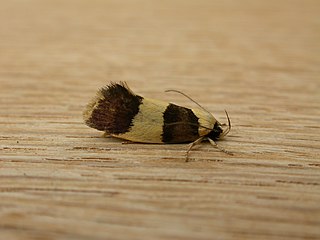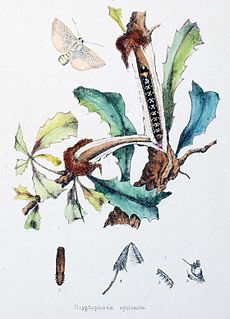
Banksia oreophila, commonly known as the western mountain banksia or mountain banksia, is a species of shrub that is endemic to the south-west of Western Australia. It has glabrous stems, wedge-shaped or narrow egg-shaped leaves with the narrower end towards the base, cylindrical spikes of pale pink to mauve flowers and later, up to twenty follicles in each spike, surrounded by the remains of the flowers. It occurs on slopes and hilltops in the Stirling and Barren Ranges.

Trigonodes hyppasia, the triangles or semi-looper, is a moth in the family Erebidae. The species was first described by Pieter Cramer in 1779. It is largely cosmopolitan, found throughout Borneo, Fiji, India, Nepal, Sri Lanka, São Tomé and Príncipe, Taiwan, Thailand, Zimbabwe, northern Australia, and almost all African countries.

Telecrates laetiorella is a moth of the family Xyloryctidae. It is known from the Australian Capital Territory, New South Wales, Queensland, South Australia and Victoria.

Macrenches clerica is a moth of the family Gelechiidae. It is known from Australia, where it has been recorded from Tasmania and south-eastern mainland Australia.
Anarsia epiula is a moth of the family Gelechiidae. It was described by Edward Meyrick in 1904. It is found in the Australian states of New South Wales and Queensland.
Scieropepla ceramochroa is a moth of the family Oecophoridae. It was described by Turner in 1919. It is found in Queensland.
Scieropepla obfuscata is a moth of the family Oecophoridae. It was described by Edward Meyrick in 1921. It is found in Queensland, Australia.
Diakonoffiana tricolorana is a species of moth of the family Tortricidae. It is found in New Caledonia, New Guinea and Australia, where it has been recorded from New South Wales and Queensland.
Apocydia pervicax is a species of moth of the family Tortricidae. It is found in Australia, where it has been recorded from Queensland, New South Wales and the Northern Territory.
Toonavora aellaea is a species of moth of the family Tortricidae. It is found in Australia, where it has been recorded from Queensland and New South Wales.
Scrobipalpa leucocephala is a moth in the family Gelechiidae. It was described by Oswald Bertram Lower in 1893. It is found in Australia, where it has been recorded form Queensland, New South Wales and South Australia.
Pancoenia periphora is a moth in the family Gelechiidae. It was described by Edward Meyrick in 1904. It is found in Australia, where it has been recorded from New South Wales.
Pexicopia epactaea is a moth of the family Gelechiidae. It was described by Edward Meyrick in 1904. It is found in Australia, where it has been recorded from South Australia.
Procometis hylonoma is a moth in the family Autostichidae. It was described by Edward Meyrick in 1890. It is found in Australia, where it has been recorded from New South Wales, Victoria, and South Australia.
Bida is a monotypic moth genus in the family Xyloryctidae described by Francis Walker in 1864. Its only species, Bida radiosella, described by the same author one year earlier, is found in Australia, where it has been recorded from New South Wales, South Australia, Tasmania, Victoria and Western Australia.
Crypsicharis neocosma is a moth in the family Xyloryctidae. It was described by Edward Meyrick in 1890. It is found in Australia, where it has been recorded from New South Wales, the Northern Territory, Queensland and Western Australia.

Cryptophasa spilonota is a moth in the family Xyloryctidae. It was described by Scott in 1864. It is found in Australia, where it has been recorded from New South Wales and Queensland.
Lichenaula comparella is a moth in the family Xyloryctidae. It was described by Francis Walker in 1864. It is found in Australia, where it has been recorded from New South Wales and Queensland.

Xylorycta strigata, the banksia web-covering borer, is a moth in the family Xyloryctidae. It was described by John Lewin in 1805. It is found in Australia, where it has been recorded from New South Wales, Queensland and South Australia.
Enteremna dolerastis is a moth in the family Depressariidae. It was described by Edward Meyrick in 1890. It is found in Australia, where it has been recorded from Western Australia.





